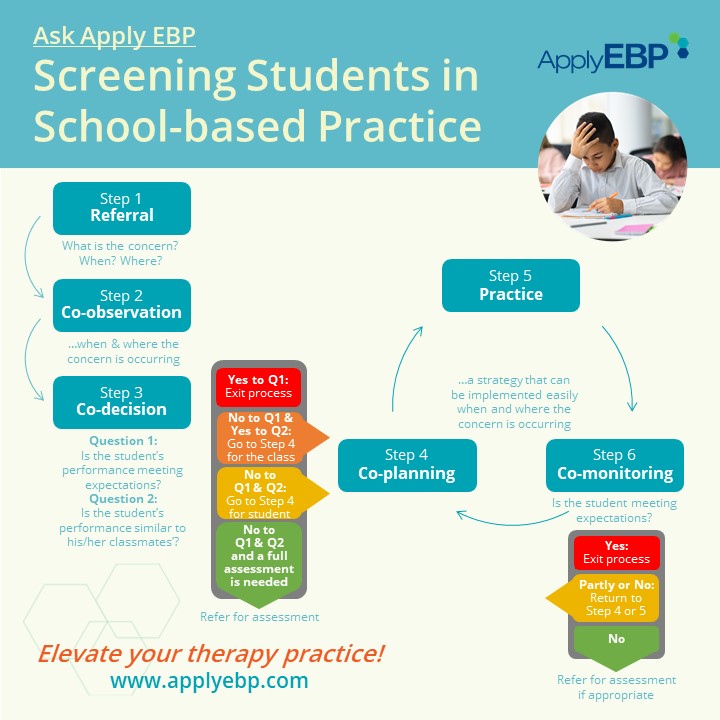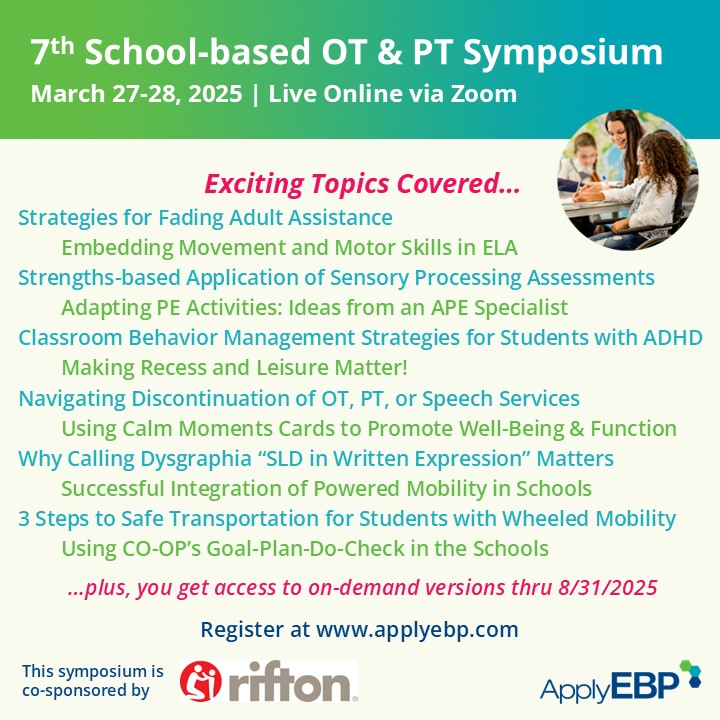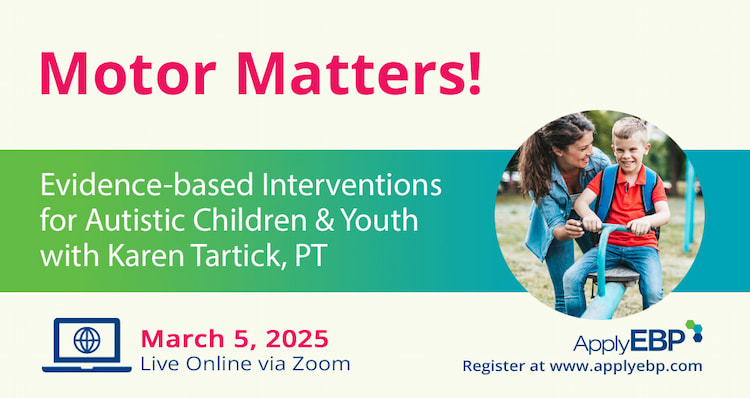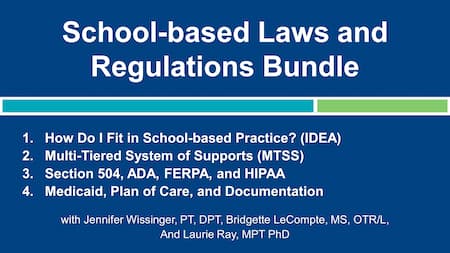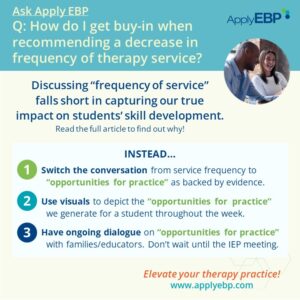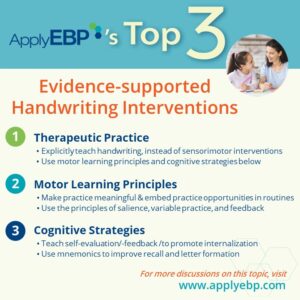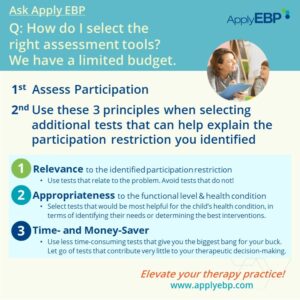Ask Apply EBP
Screening Students in School-based Practice
Question: I was asked to screen a student who is having difficulties in school. What should I do? Is there a standardized tool that I can use?
As related services, what we do should relate back to the student’s school needs! So we don’t recommend pulling out the student for an individualized testing when you receive a request for screening. Come to think of it, the student’s reported difficulty does not occur in a vacuum, but within the context of when, where and what they are doing. What we recommend is figuring out and addressing the student’s needs within the context of where that need is occurring. See our suggested 6 Steps for screening above.
Step 1 is the Referral, which should include answers to “What is the concern? When and where does it happen?” If you don’t have the answer to these, interview the referrer. If you often receive a referral without this information, create and use a short referral form that contains these questions. You can also ask about “What strategies were tried? What were the results?”
Step 2: Together with the teacher and/or relevant school personnel (e.g., paraeducator), co-observe the child when and where the concern is occurring. See what is happening, where the breakdown is, what is hindering performance, and what are potential facilitators for success. Don’t just focus on the child. Consider the environment (physical and social) and the task itself (e.g., instructions given, materials).
Step 3: Based on the observation, make a co-decision on:
-
-
- Question 1: Is the student’s performance meeting expectations?
- Question 2: Is the student’s performance similar to his/her classmates’?
-
Depending on your answers to these 2 questions, use the traffic light we provided to know whether you should…
-
-
- Red: Yes to Q1, which means the student is doing ok…Exit the process.
- Orange: No to Q1, Yes to Q2 means the whole class may be having difficulties…Proceed to Step 4 targeting the whole class.
- Yellow: No to Q1 and Q2 means the student is having difficulties…Proceed to Step 4 targeting the student.
- Green: No to Q1 and Q2, and you think that the student’s needs are such that a full assessment is warranted…Refer for Assessment. And since you already observed the student in action, you have good data to start off your assessment with!
-
A quick note before you proceed to the next 3 stages: if you think the issue identified and/or potential solutions are outside your expertise, refer/involve the appropriate school personnel.
Step 4: Co-plan a strategy that can be implemented easily when and where the problem is occurring. Don’t just focus on strategies that are directed towards the child. Sometimes a strategy directed at the environment and/or task are easier to implement, and can result in more immediate improvement. It is important to implement only 1 strategy at a time for 2 good reasons: (1) so you do not overwhelm the teacher/relevant personnel; and (2) so you can identify what truly works! So try out a few strategies with the student to select the one that you think will make the biggest difference. Model and practice implementation of the selected strategy with the teacher and/or relevant personnel.
Step 5: Practice the strategy when and where the problem is occurring. Here the teacher/personnel applies the strategy with the student. Your role is to check in, be a cheerleader to ensure that the strategy is being utilized, and help problem-solve, as needed. If it’s a strategy that can be applied multiple times a day (say during toileting 3 times a day), you should know within 2 weeks whether it works or not. Strategies that are applied less often (say, during PE class only) may take longer to figure out whether it works (4-6 weeks). So, think of opportunities to apply the strategy more often.
Step 6: Co-monitor: Is the student now meeting expectations? Use our 2nd traffic light.
-
-
- Red: Yes! Exit the process, and keep on using the strategy as long as it is needed.
- Yellow: Partly or No…Return to Step 4 to co-plan a new strategy, or Step 5 to continue practice of strategy.
- Green: No, and a full evaluation is warranted…Refer for assessment if appropriate, or refer to another school personnel.
-
Now that you’ve seen our suggestion and you think it is something that you would want to try, note the following. Check your state or school’s existing policies and regulations, as well as your state OT/PT/SLP practice act to know what you are allowed and not allowed to do. If you can’t use all of these steps, figure out which concepts in this article your team can integrate into your current process. By the way, you probably already noticed that the above steps, with some tweaks, may fit nicely into your school’s RtI or MTSS process (that’s a discussion for another time). Finally, the above process may not be appropriate in some cases, such as when you are asked to screen incoming Pre-K students that you do not have the opportunity to observe in context. Download the full infographics by clicking here. Happy screening, and let us know below if you have any other questions, or share a screening strategy that works for you.
P.S. Here is an interesting research article with some similar concepts as those discussed above. If you enjoy reading it, search for the other research on context-focused interventions that followed this paper: Darrah, J., Law, M. C., Pollock, N., Wilson, B., Russell, D. J., Walter, S. D., … & Galuppi, B. (2011). Context therapy: a new intervention approach for children with cerebral palsy. Developmental Medicine & Child Neurology, 53(7), 615-620.
Here at Apply EBP, we do the heavy lifting of presenting the current evidence and how you apply them into your decision-making and intervention planning. Check out these upcoming courses:
Find More Answers to Your Questions in Our...
Featured School
Symposium
6th Online School-based OT and PT Symposium - On-demand Version
- Watch and re-watch on your own time
- On-Demand Version
- OTs, OTAs, PTs and PTAs
- $399-449
Featured Live
Workshop
Featured On-Demand
Webinar
Screening for School-based Services
Featured Webinar
Bundle
School-based: Laws & Regulations
Have a question?
Submit here…
*Clicking submit will send your question directly to our email inbox. Your name and email will let us know that your submission is real (not spam). We will not include these in our posts, unless you tell us to include your name. Please read our privacy policy here.
All infographics and videos on www.applyebp.com are intellectual properties of Apply EBP, LLC
You may use the infographics and videos for free for any non-commercial, educational purposes. Please cite the source as “Apply EBP, LLC” and a link to the source article. If you plan to use any infographic or video for commercial purposes (i.e., for profit), please email Carlo@applyebp.com to obtain a written permission. Permission can be granted on a case-by-case basis.

